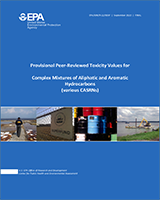From: EXECUTIVE SUMMARY

NCBI Bookshelf. A service of the National Library of Medicine, National Institutes of Health.
| Fraction and Carbon Range | Assessment Method | OSF (mg/kg-d)−1 a | IUR (mg/m3)−1 a |
|---|---|---|---|
| Aliphatic | |||
|
Low (C5–C8 [EC5–EC8])b | Surrogate mixture | NA; data do not support cancer risk assessment |
2.0 × 10−4 (commercial hexane) |
|
Medium (C9–C18 [EC > 8–EC16]) | Surrogate mixture | NA; data do not support cancer risk assessment |
4.5 × 10−3 (mid-range aliphatic hydrocarbon streams) |
|
High (C19–C32 [EC > 16–EC35]) | NA; data do not support cancer risk assessment | ||
| Aromatic | |||
|
Low (C6–C8 [EC6–EC < 9]) | Indicator chemical | Benzene: 1.5 × 10−2–5.5 × 10−2 | Benzene: 2.2 × 10−3–7.8 × 10−3 |
|
Medium (C9–C10 [EC9–EC < 11])b | NA; data do not support cancer risk assessment | ||
|
High (C10–C32 [EC11–EC35])b |
Indicator Chemical (Option 1); Relative Potency Factor (Option 2); Integrated Addition (Option 3) |
1,1-Biphenyl: 8 ×10−3 1-Methylnaphthalene: 2.9 × 10−2 Benzo[a]pyrene: 1 See relative potency values in Table 20 | Benzo[a]pyrene: 6 × 10−1 |
Toxicity values in italics PPRTV are screening values. Screening values are not assigned confidence statements; however, confidence in these values is presumed to be low. Screening values are derived when the data do not meet all requirements for deriving a provisional toxicity value. Screening values are derived using the same methodologies and undergo the same development and review processes (i.e., internal and external peer review, etc.) as provisional values; however, there is generally more uncertainty associated with these values.
Toxicity value(s) updated in 2022 (U.S. EPA, 2022a, b, d).
C = carbon; EC = equivalent carbon; IUR = inhalation unit risk; NA = not applicable; OSF = oral slope factor; PAH = polycyclic aromatic hydrocarbon; RPF = relative potency factor.
From: EXECUTIVE SUMMARY

NCBI Bookshelf. A service of the National Library of Medicine, National Institutes of Health.